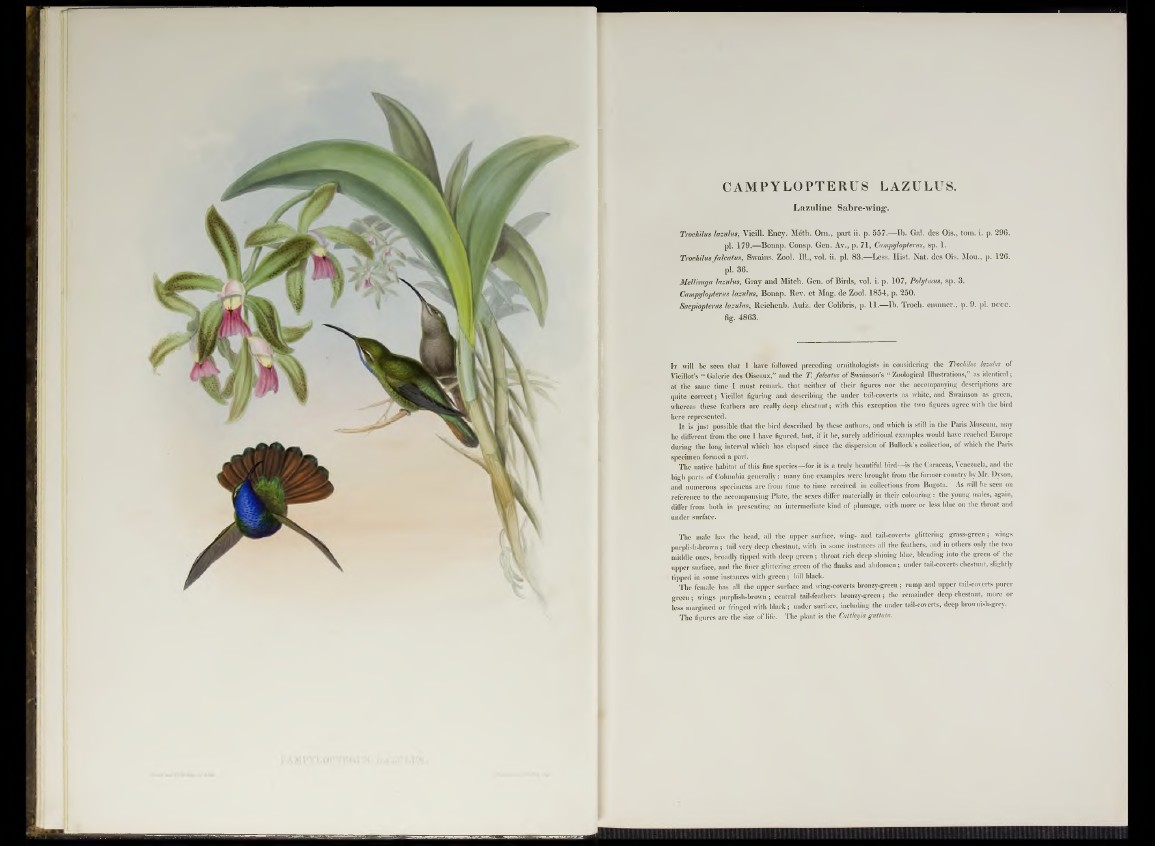
CAMPYLOPTERUS LAZULUS.
Lazuline Sabre-wing.
Trochilus lazulus, Vieill. Ency. Méth. Om., part ii. p. 557.—Ib. Gal. des Ois., tom. i. p. 296.
pl. 179.—Bonap. Consp. Gen. Av., p. 71, Campylopterus, sp. 1.
Trochilus falcatus, Swains. Zool. 111., vol. ii. pl. 83.—Less. Hist. Nat. des Ois. Mou., p. 126.
pl. 36.
Mellisuga lazulus, Gray and Mitch. Gen. of Birds, vol. i. p. 107, Polytmus, sp. 3.
Campylopterus lazulus, Bonap. Rev. et Mag. de Zool. 1854, p. 250.
Saepiopterus lazulus, Reichenb. Aufz. der Colibris, p. 11.—Ib. Troch. enumer., p. 9. pl. d c c c .
fig. 4863.
It will be seen that I have followed preceding ornithologists in considering the Trochilus lazulus of
Vieillot’s “ Galerie des Oiseaux,” and the T. falcatus of Swainson’s “ Zoological Illustrations,” as identical;
at the same time I must remark, that neither of their figures nor the accompanying descriptions are
quite correct; Vieillot figuring and describing the under tail-coverts as white, and Swainson as green,
whereas these feathers are really deep chestnut; with this exception the two figures agree with the bird
here represented.
It is just possible that the bird described by these authors, and which is still in the Paris Museum, may
he different from the one I have figured, but, if it be, surely additional examples would have reached Europe
during the long interval which has elapsed since the dispersion of Bullock’s collection, of which the Paris
specimen formed a part.
The native habitat of this fine species—for it is a truly beautiful bird—is the Caraccas, Venezuela, and the
high parts of Columbia generally: many fine examples were brought from the former country by Mr. Dyson,
and numerous specimens are from time to time received in collections from Bogota. As will be seen on
reference to the accompanying Plate, the sexes differ materially in their colouring: the young males, again,
differ from both in presenting an intermediate kind of plumage, with more or less blue on the throat and
under surface.
The male has the head, all the upper surface, wing- and tail-coverts glittering grass-green; wings
purplish-brown ; tail very deep chestnut, with in some instances all the feathers, and in others only the two
midtlle ones, broadly tipped with deep green; throat rich deep shining blue, blending into the green of the
upper surface, and the finer glittering green of the flanks and abdomen ; under tail-coverts chestnut, slightly
tipped in some instances with green; bill black.
The female has all the upper surface and wing-coverts bronzy-green; rump and upper tail-coverts purer
green; wings purplish-brown; central tail-feathers bronzy-green; the remainder deep chestnut, more or
less margined or fringed with black; under surface, including the under tail-coverts, deep brownish-grey.
The figures are the size of life. The plant is the Cattleyia guttata.